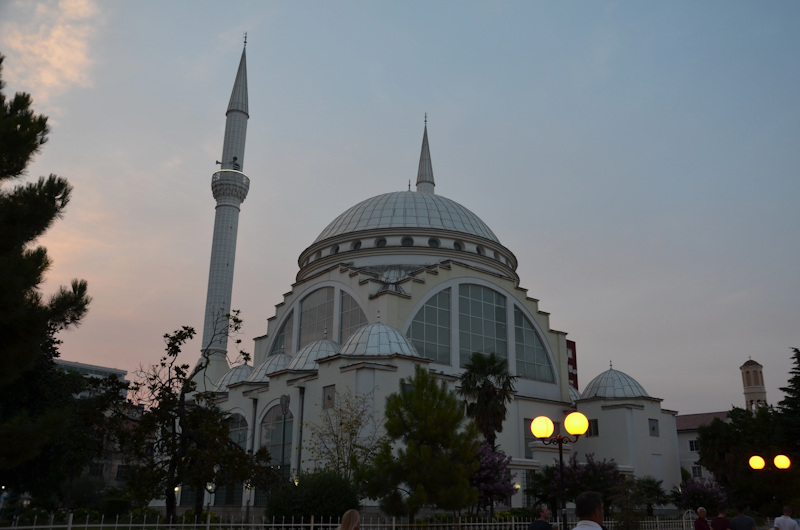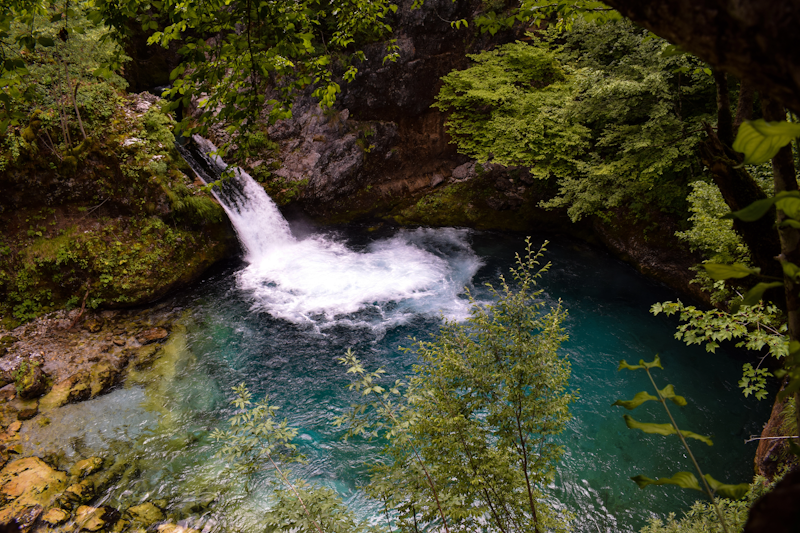Perched above the city of Shkodër, Rozafa Castle is named after Rozafa, a legendary young woman who was unjustly sacrificed for the castle's construction. Its 9-hectare area, divided into three main courtyards, bears traces of Illyrian, Ottoman, and Venetian civilizations. The first courtyard contains medieval ruins of the Balshaj towers and a 4th-century BC Illyrian wall, the oldest part of the castle. The second and third courtyards respectively contain the ruins of Sultan Mehmet Fatih's mosque and a three-story Venetian period building known as the Captain's House, which today houses the Shkodër Castle Museum. The museum provides information about the castle's 2000-year history and the city's most important medieval families. Outside, the battlements offer impressive views of Lake Shkodër and the meeting point of the Drin, Kir, and Buna rivers.
Welcome to Shkodër!
A 13th-century Byzantine fortress that primarily served as a settlement, Drivasti Castle gradually became one of the chain fortresses protecting Shkodër. Today, within its walls, one can see the towers, churches, and the castle's garden, silent witnesses to its 800-year history.
The Marubi Museum offers a vivid look at the evolution of photography in Albania and the country's history through approximately 500,000 exhibited objects. These range from portraits of notable people, various ethnocultural customs, to the country's major historical events. Divided into three parts, dedicated to Pietro, Kel, and Gegë Marubi, the museum also features photographs by other notable Shkodran artists such as Kolë Idromeno, Shan Pici, Dedë Jakova, Pjetër Rraboshta, and Angjelin Nenshati. These works serve as testimonies to the development of photography during that period. The Marubi Museum is open daily from 09:00 to 16:00 (Sunday 10:00 to 15:00) and offers various ticket prices depending on the visitor, with a regular ticket costing 700 lekë.
Opened in 1947, the Shkodra Historical Museum consists of the central museum, located in the Oso Kuka House, and the Rozafa Castle museum. The museum features four sections dedicated to ethnography, archaeology, visual arts, and the museum library.
The Place of Witness and Memory is a museum dedicated to communist persecution in Shkodër. Alongside objects and imprisonment materials brought by the political convicts themselves or their families, the museum also displays original documents that testify to the first anti-communist uprisings in Albania, military trials, the persecution of the clergy, internments, escapes, and executions. The museum is divided into two floors with 23 cells each, one of which housed Father Zef Pllumi, a well-known figure in Albanian journalism. The museum can be visited from Monday to Saturday, generally from 08:30 to 14:30, and offers various ticket prices depending on the visitor, with a regular ticket costing 150 lekë.
The Diocesan Museum presents a historical journey through the Christian identity of Albanians from antiquity to the present day. Divided into two main parts, the museum offers a view of the Christian tradition, its importance, and the difficulties that practitioners have faced to keep it alive through artistic works, church items, documents, and testimonies. The museum can be visited every day from Monday to Friday from 09:00 to 17:00 near the Great Church. The ticket costs 100 lekë.
Located in a 300-year-old tower, the Theth Ethnographic Museum offers a tableau of daily life in Gegëria with displays of clothing, work tools, weapons, and household items. Unfortunately, the museum is currently in need of restoration interventions, and thus, its visitation has no fixed schedule.
At the foot of Rozafa Castle, the Lead Mosque is the only Albanian mosque listed among the 50 most beautiful Islamic structures in the world. Its location near the rivers has caused the mosque to be flooded several times. The Lead Mosque was built in 1774 by Mehmet Pashë Bushatlliu with blue and white stones and domes covered with lead, which gave it its name. Unique elements of the mosque include its courtyard with columns in front of the prayer hall and the absence of the minaret, which was demolished in 1967 due to a lightning strike. After the interruption of religious activity during the communist period, the Lead Mosque was returned to the Muslim community in the '90s.
Ebu Beker Mosque, also known as the Great Mosque, was built in 1995. It was erected on the same territory as the Fushë-Çelë Mosque, an Ottoman period mosque that was demolished during the communist years. Today, the Great Mosque remains the main mosque in the city of Shkodër.
The Cathedral of Saint Stephen, or the Great Church, was built in 1867 after monetary contributions from several historical figures such as the Sultan, the Pope, and the Emperor of Austria-Hungary, as well as various volunteers from Shkodran Catholic families. The cathedral has a 23.5-meter-high arched ceiling decorated with frescoes by Kolë Idromeno, featuring details such as Our Lady of Shkodër, angels dressed in Shkodran costumes, and the Rozafa Castle. During the communist period, the cathedral was turned into a sports hall and reopened its doors to Catholic believers as a church in 1991.
The Franciscan Monastery is located in the Gjuhadol area. Built in 1906, the history of the Monastery is closely linked with several important figures of the country such as Gjergj Fishta and Shtjefën Gjeçovi, both friars of this Monastery. During the communist period, the Monastery and the Franciscan Church served various functions such as a prison, a cooperative office, a children's nursery, and a cinema, returning to its original function after the '90s.
The Church of the Assumption of Mary, often called Theth Church, is located in the center of the village of Theth with foundations dating back to 1892. In the 1900s, its premises served as a school under the care of Father Shtjefën Gjeçovi, while during the communist period it was turned into a health center. After the '90s, the church was rebuilt with alpine architecture and returned to its religious function. Today it stands as one of the most recognizable sights of the village of Theth.
Gjuhadol is one of the most populated historical areas of the city, where several important buildings are located such as the Gurakuqi House, the Franciscan Monastery, and Kolë Idromeno's House. The cobblestone streets and numerous cafes in all its corners make Gjuhadol a starting point for any visit to Shkodër.
With a length of 108 meters, Mesi Bridge is the longest bridge in Albania from the Ottoman Empire period. It connects Shkodër with Drivasti, crossing the picturesque Kir River. Featuring 13 stone arches, the bridge is a notable cultural monument and a popular site for visitors to the city.
King Zog's Villa was a gift from Shkodran merchants to King Zog located in the tourist area of Shiroka. Over time, the villa has suffered numerous damages, even being set on fire in 2001, but still continues to attract visitors' interest for its architecture designed by Kolë Idromeno.
Grand Cafe is one of the iconic buildings that has helped to recognize Shkodër as a cultural cradle in Albania. Divided into two floors, the lower part functioned as a cafe-salon with about 50 tables dedicated to rest, intellectual discussions, and games like billiards, chess, etc. The second floor served as a hotel with 9 bedrooms and 2 shared bathrooms. In its over 100-year history, Kolë Idromeno's project suffered increased degradation after the system changed in the '90s and is currently undergoing reconstruction.
The Lock-up Tower is a three-story stone tower with small windows, mentioned in the notes of researchers such as Edith Durham, Baron Nopcsa, and Father Shtjefën Gjeçovi. It served for the confinement of offenders and for reconciling affected families. Inside, there is a wooden table, some skins for lying down, eating utensils, and a rifle.
Focus







With deep valleys, glacial cirques, and dense forests, the Albanian Alps constitute the highest mountain backbone of the Dinaric Alps. They include numerous rocky peaks such as Radohima, Shkëlzen, Hekurave, Harapi, and Jezerca, which, at 2694 meters, marks the highest point in them. One of these peaks also houses the Puç Cave, the largest cave in Albania. Their plateaus are adorned with a multitude of glacial lakes, 30 of which are gathered only in the Gashi Highlands. Pines, firs, and chestnuts shelter characteristic animals such as bears, lynxes, and the mountain eagle. The place comes to life from the cold waters of Valbona, Shala, and Cemi rivers, which with their freshness nourish and keep alive the wild nature of the Albanian Alps.
Theth National Park offers a breathtaking view of wild nature, with high rocky peaks and cold waters. The park spans 2630 hectares and welcomes up to 10,000 visitors per year. It is home to a rich variety of flora and fauna, including 1500 plant species and animals such as the brown bear, lynx, and roe deer. At its northernmost edge lies the village of Okol, the starting point of the Shala River, one of the longest rivers in the park. Along its banks, umbrellas and tents are set up for beach and camping by numerous holidaymakers. In the center of the park, the Theth Church is one of the most photographed monuments in the area. A novelty here is the zipline descent, which offers a new way to experience the park. Near the church is the Lock-up Tower, a place where blood feuds in Albania were judged, condemned, and reconciled. For hiking enthusiasts, the Grunas and Kaprre Canyons offer numerous opportunities for trekking. The latter leads through the Stone Bathtubs to the Blue Eye, one of the most visited places in the park, a symbol of Theth's natural beauty.
Amidst the greenery and the blue of the river, Shala Valley offers an opportunity to reconnect with nature, far from modern life. Hiking in the mountains, exploring the rocky shores, and camping in the forests are part of the adventure for the numerous visitors to the area. Down the river, the beaches and boat rides are a perfect choice for the summer season.
Grunas Canyon stretches across the Theth area, with a length of 2 kilometers and a width that reaches up to 30 to 40 meters. Besides offering beautiful views, Grunas Canyon is also suitable for canoeing. At its entrance, the Grunas Waterfall is formed. With a height of 25 meters, this waterfall offers a multitude of reflections and colors as a reward for the several-hour hikes required to reach it.
The Stone Bathtubs are a rocky formation in the Kaprre Canyon in Theth with smooth, pinkish-white surfaces. Created by the continuous erosion of the Black River, the larger pits provide a refreshing escape from the hot days.
Located amidst a beech forest in the Theth Highlands, the Blue Eye is a water pool with a depth of up to 5 meters. Reaching the Blue Eye requires about 3.5 hours of hiking along the Stone Bathtubs in Ndërlysaj and the rocky trails of Kaprre. The destination offers visitors an impressive view with blue or emerald colors depending on the season.
With an area of 368 square kilometers, Shkodra Lake is the largest lake in the Balkans. Adorned with water lilies, it is a popular destination for numerous holidaymakers for beach activities, water sports, and scenic walks along its shores. The areas around the lake serve as a refuge for 270 different bird species, nearly 80% of all birds in Albania. Nature photographers can capture various moments from the life of storks, pelicans, and even the national emblematic bird, the eagle.
The Molo Promenade is one of the most popular places in Shkodër. Located near the Buna River, with fresh air and numerous benches along the way, it remains one of the most visited places during summer evenings.
Located between Mount Tarabosh and Lake Shkodër, the tourist village of Shiroka offers a peaceful atmosphere with beaches, bicycles, and traditional restaurants. Its promenade, adorned with motifs from Albanian carpets, has been nominated as the European place with the best contemporary architecture for 2022. On the hill, King Zog's Villa completes the visits of many curious people who come to see up close what remains of Kolë Idromeno's project.
Velipoja Beach stretches from Viluni Lagoon to Rana e Hedhun. Numerous boats along the coastline and various restaurants under the shade of trees offer a family-friendly atmosphere for a peaceful vacation.
Focus



Zâ Fest is a festival that combines Geg folk music with various contemporary genres. Held in the natural squares of Theth National Park or the Rozafa Castle, Zâ Fest gathers thousands of art lovers every year in a show of colors and emotions.
Swing Marathon, Andrra N'Tren is a traveling jazz festival held every year on , the international day of this genre. Various musical groups and numerous dancers accompany a train journey from Tirana to Shkodër under the sounds of swing and jazz music. The cheerful atmosphere continues in the historical streets of Shkodër and culminates with a concert at the Migjeni Theater.
Shkodra Jazz Fest is another festival dedicated to jazz music in all its forms. Every year, numerous performances in classical, contemporary, ethnic, gypsy, and Latin jazz, along with educational activities, turn Shkodër into a welcoming home for all jazz lovers from around the world.
Carnivals are a celebration with religious origins characterized by the humor of Shkodran bejtes and Venetian masks. With traces dating back to the 1850s, they constitute an important event in Shkodran culture. The city's band, colorful costumes, and comic characters fill the streets in a lively and festive parade. Carnivals last three days and end with the burning of a scarecrow, symbolizing the year's misfortunes.
Venice Art Mask Factory is one of the most famous workshops in the world for creating Venetian masks. It produces over 30,000 masks every year that are exported to various countries from Dubai to Australia. They are widely featured in carnivals, home decorations, and even Hollywood movies, such as Stanley Kubrick's Eyes Wide Shut. These, along with 700 to 800 other models like Bauta, Arlecchino, Columbina, and the Plague Doctor, are displayed in a museum, accessible to all local and foreign visitors.
Shkodra Lake Day is celebrated every year on and marks the opening of the tourist season for the Shiroka area. A day when all the restaurants by the lake offer their traditional specialties, Shkodra Lake Day is also accompanied by water games such as swimming, water polo, and rowing, making it a delightful way to enjoy the Shkodran summer.
Folk Games Fest is held every year on at Rozafa Castle and serves as a traditional celebration filled with folk clothing, instruments, and various sports. The focus is on the xhubleta, the characteristic northern dress, and music played with leaves, an ancient musical tradition of the area.
The National Children's Song Festival is the most important cultural event for children's music in Albania. Established in 1963 as a regional festival in Shkodër, this festival gained national status in 1993. Since then, the festival gathers every year in Shkodra new talents from all over Albania, simultaneously contributing to the enrichment of the Albanian repertoire of children's songs.
AniFest Rozafa is a festival dedicated to animated films. Started in 2010, AniFest has recently gained worldwide recognition with entries from more than 50 countries.
Focus
In a city surrounded by water, carp casserole is the most famous dish of Shkodran cuisine. Cooked with onions, garlic, vinegar, dried plums, and bay leaves, carp casserole is a must-try for anyone who decides to have lunch in Shkodër. It can be easily found in most restaurants.
Yahni is a dish popular throughout Albania, but in Shkodër, it is accompanied by plums. Beef with onions and garlic is combined with tomato sauce, vinegar, spices, and plums, and cooked slowly for added flavor.
Bare Pie with Zucchini is a form of pie with zucchini without the top and bottom layers of dough. The liquid filling consists of zucchini, milk, butter, eggs, sugar, and salt. In Shkodran restaurants, it is a delicious alternative for breakfast or lunch.
Different cities in Albania have their traditional form of sheqerpare in their dessert menus, and in Shkodër, this role is filled by haxhimakulle. Made with egg yolks, flour, butter, soda, and sugar, a well-made haxhimakulle is served soft and crumbly. A characteristic feature is the almond or hazelnut placed on top of the dessert before baking.
Tespixhe is another widely spread traditional dessert. In Shkodër, it is made with a mixture of wheat and corn flour, soda, butter, and sugar. Usually cut in diamond shapes, cold syrup is poured over the baked tray, making it ready to be enjoyed.
Focus




